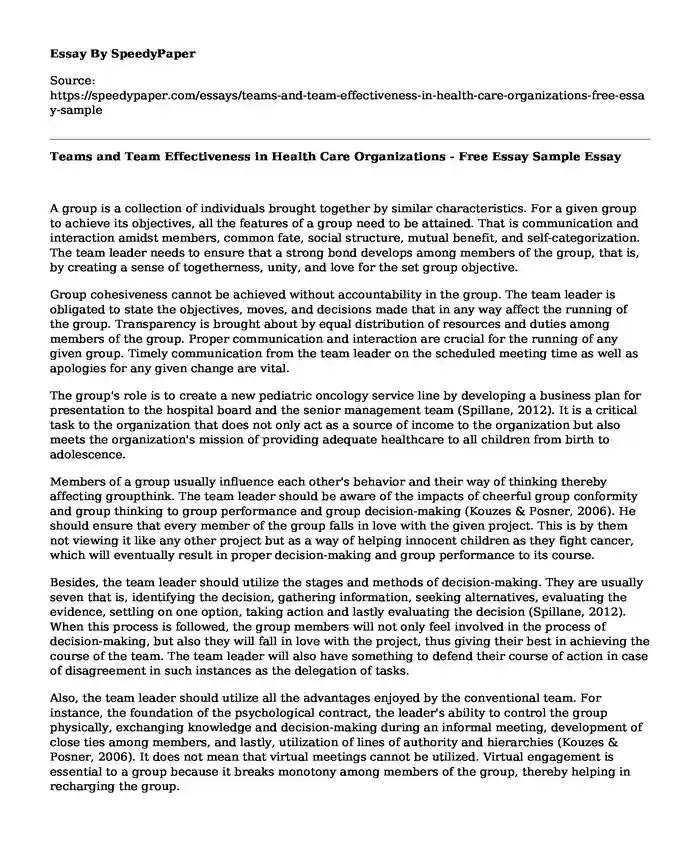
| Type of paper: | Essay |
| Categories: | Leadership analysis Health and Social Care Communication |
| Pages: | 3 |
| Wordcount: | 635 words |
A group is a collection of individuals brought together by similar characteristics. For a given group to achieve its objectives, all the features of a group need to be attained. That is communication and interaction amidst members, common fate, social structure, mutual benefit, and self-categorization. The team leader needs to ensure that a strong bond develops among members of the group, that is, by creating a sense of togetherness, unity, and love for the set group objective.
Group cohesiveness cannot be achieved without accountability in the group. The team leader is obligated to state the objectives, moves, and decisions made that in any way affect the running of the group. Transparency is brought about by equal distribution of resources and duties among members of the group. Proper communication and interaction are crucial for the running of any given group. Timely communication from the team leader on the scheduled meeting time as well as apologies for any given change are vital.
The group's role is to create a new pediatric oncology service line by developing a business plan for presentation to the hospital board and the senior management team (Spillane, 2012). It is a critical task to the organization that does not only act as a source of income to the organization but also meets the organization's mission of providing adequate healthcare to all children from birth to adolescence.
Members of a group usually influence each other's behavior and their way of thinking thereby affecting groupthink. The team leader should be aware of the impacts of cheerful group conformity and group thinking to group performance and group decision-making (Kouzes & Posner, 2006). He should ensure that every member of the group falls in love with the given project. This is by them not viewing it like any other project but as a way of helping innocent children as they fight cancer, which will eventually result in proper decision-making and group performance to its course.
Besides, the team leader should utilize the stages and methods of decision-making. They are usually seven that is, identifying the decision, gathering information, seeking alternatives, evaluating the evidence, settling on one option, taking action and lastly evaluating the decision (Spillane, 2012). When this process is followed, the group members will not only feel involved in the process of decision-making, but also they will fall in love with the project, thus giving their best in achieving the course of the team. The team leader will also have something to defend their course of action in case of disagreement in such instances as the delegation of tasks.
Also, the team leader should utilize all the advantages enjoyed by the conventional team. For instance, the foundation of the psychological contract, the leader's ability to control the group physically, exchanging knowledge and decision-making during an informal meeting, development of close ties among members, and lastly, utilization of lines of authority and hierarchies (Kouzes & Posner, 2006). It does not mean that virtual meetings cannot be utilized. Virtual engagement is essential to a group because it breaks monotony among members of the group, thereby helping in recharging the group.
Lastly, approaches and barriers to significant team building need to be observed. Members of a team should create a new pediatric oncology service line by developing a business plan for presentation to the hospital board and the senior management team as their project. The approaches and barriers to significant team building such as members shirking duties, lack of trust in the leader, skewed influence over decisions, stuck in formation, conflict hampering the process, and lack of task skills need to be scrutinized and looked into appropriately by the team leader (Spillane, 2012).
Reference
Kouzes, J. M., & Posner, B. Z. (2006). The leadership challenge (Vol. 3). John Wiley & Sons.
Spillane, J. P. (2012). Distributed leadership (Vol. 4). John Wiley & Sons.
Cite this page
Teams and Team Effectiveness in Health Care Organizations - Free Essay Sample. (2023, Dec 08). Retrieved from https://speedypaper.net/essays/teams-and-team-effectiveness-in-health-care-organizations-free-essay-sample
Request Removal
If you are the original author of this essay and no longer wish to have it published on the SpeedyPaper website, please click below to request its removal:
- Free Essay with a Speech Sample Dedicated to Diabetes
- Pacelle, R. (2018). The role of the Supreme Court in American politics: The least dangerous
- Paper Example on Nosocomial Infection With Urinary Catheter-Associated Urinary Tract Infection
- Free Essay. Role of Price Control in Achieving Affordable Healthcare
- Paper Example. A Debate Over Strategy
- Free Paper Sample on Design Thinking
- Paper Sample on Personal and Professional Philosophy
Popular categories




